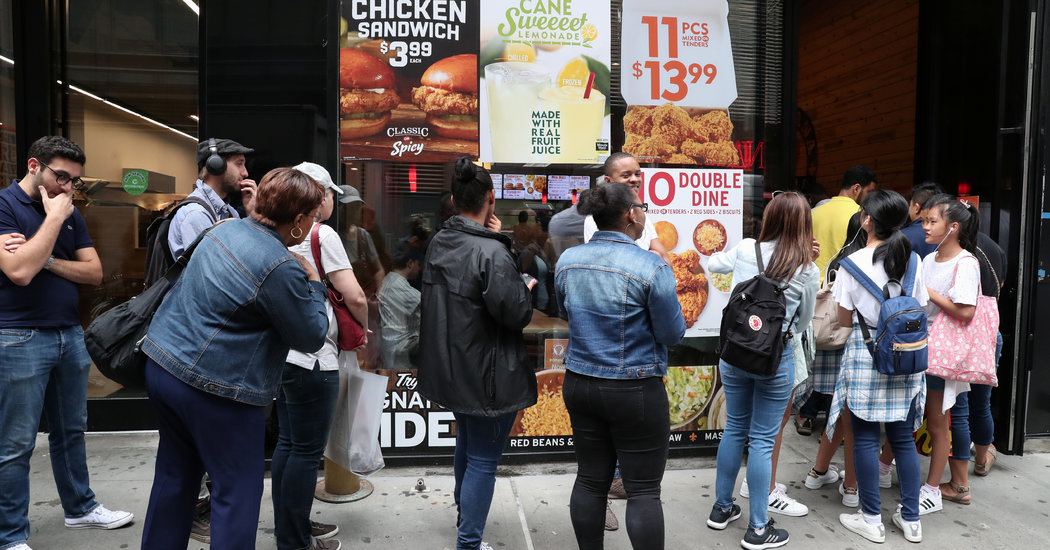
They started a war in 15 minutes.
At 1:43 p.m. on Aug. 19, Bruno Cardinali, a marketing executive for Popeyes Louisiana Kitchen, got a WhatsApp message from a colleague: That morning, one of Popeyes’ fast-food rivals, Chick-fil-A, had tweeted what appeared to be a thinly veiled critique of the new fried chicken sandwich that Popeyes had started offering nationwide a few days earlier.
Mr. Cardinali quickly convened a group of marketing officials in a small room on the fifth floor of the Popeyes headquarters in Miami. A high-speed brainstorming session ensued, and before long, the team settled on what seemed like the perfect response: “… y’all good?”
The tweet appeared on the official Popeyes account at 1:58 p.m.
“It was 15 minutes of turnaround putting out the tweet that triggered the whole thing,” Mr. Cardinali said. “And at that moment, we braced ourselves.”
What the tweet set off were the “chicken sandwich wars,” a viral social media debate that has captivated the internet for the last week and a half. Popeyes, Chick-fil-A and other fast-food brands traded barbs on Twitter, arguing about whose sandwich tasted best. As sandwich memes proliferated, customers flocked to Popeyes restaurants across the country, forcing employees to work hours of overtime as location after location sold out of the sandwiches.
As the chain’s sandwich supply rapidly dwindled, top Popeyes executives working behind the scenes in Miami were ebullient: A two-word tweet had turned the chicken sandwich rollout into the most successful product launch in the company’s history. But the success of the sandwich was also creating a logistical headache.
In a tweet on Tuesday, Popeyes announced that its chicken sandwich inventory was exhausted: For the time being, the chain said, its stores would have to stop offering the sandwich, which sold for $3.99. (Popeyes declined to reveal how many sandwiches it had sold over the last week and a half.)
“We had very aggressively forecasted the demand, and we thought we wouldn’t have any problems at all, at least until the end of September,” said Felipe Athayde, the Popeyes president for the United States market. “And then two weeks go by, and we’re out of the product on a national level.”
All of last week, Mr. Athayde had fielded calls and emails about the shortages. But it wasn’t until that Friday evening that he made a decision. The chain’s senior leadership had gathered in a fifth-floor meeting room. Some officials were on laptops, while others examined printed spreadsheets showing sandwich sales across the country.
“Guys, look,” Mr. Athayde said to the group. “I think we’re going to have to hit the brakes.”
In the end, the decision came down to simple mathematics, Mr. Athayde said in an interview this week. With 2,400 locations, Popeyes is one of the largest fried chicken chains in the United States. But it did not have enough chicken to keep making the sandwiches.
“We made a decision to stop, but technically, it wasn’t a decision,” Mr. Athayde said. “We came to the realization we were stopping. There was no alternative.”
In the coming months, the chain plans to recruit new chicken suppliers to secure greater quantities of the particular cut of breast meat used in the sandwich, said Amy Alarcon, the vice president for global culinary innovation at Popeyes. (A company spokeswoman would not reveal the names of any of the suppliers.)
On Saturday, Mr. Athayde held a webcast at the Popeyes headquarters for hundreds of franchises across the United States in which company executives outlined their plan to suspend sales of the chicken sandwich. On the call, they emphasized that the sandwich launch had been a historic moment for Popeyes. But ultimately, the officials acknowledged, the chain simply ran out of chicken breast.
Now the plan is to come back “full throttle,” Mr. Athayde said in the interview.
Popeyes has not set a date for the return of the product, but at some franchises, the preparation has already begun. Joe Haberkorn, who owns six Popeyes stores in the Chicago area, said he planned to install new sandwich-making stations at his restaurants.
“We’re ordering additional toasters,” Mr. Haberkorn said. “We’re going to hit it in high gear when they come back.”
But there are already signs that consumers are moving on to other viral chicken products. In about five hours on Tuesday, one of Popeyes’ rivals, KFC, sold its entire test supply of a new plant-based fried chicken at an Atlanta branch.
For Popeyes employees, the suspension of chicken sandwich sales signaled the end of a chaotic week of overtime shifts and sometimes-hostile interactions with impatient customers.
Brian Smith, a franchise owner who runs 11 Popeyes locations in the Midwest, said that last week he sold 1,200 sandwiches a day at his restaurant in Appleton, Wis. It came as a relief that his overworked employees did not quit on the spot, he said.
“It was so stressful,” Mr. Smith said. “I’m amazed that team members stayed. It was absolutely just mayhem.”
At a Popeyes in Affton, Mo., a suburb of St. Louis, store managers arranged for several additional staff members to work certain shifts, according to Eric Janis, 19, a cook at the restaurant. Last week, Mr. Janis said, some impatient customers waiting in line for the chicken sandwiches screamed at store employees to hurry up.
“Every day, they were shouting about how long it takes,” he said. “There was constant complaining.”
The wait will now be much longer. At lunchtime on Wednesday, the Popeyes on Brooklyn Avenue in Bedford-Stuyvesant was quiet. A message written in black Sharpie on a cardboard sign hanging from the menu board offered a hint as to why the lines had disappeared.
“Sorry for the inconvenience,” it read. “We are out of sandwiches.”




